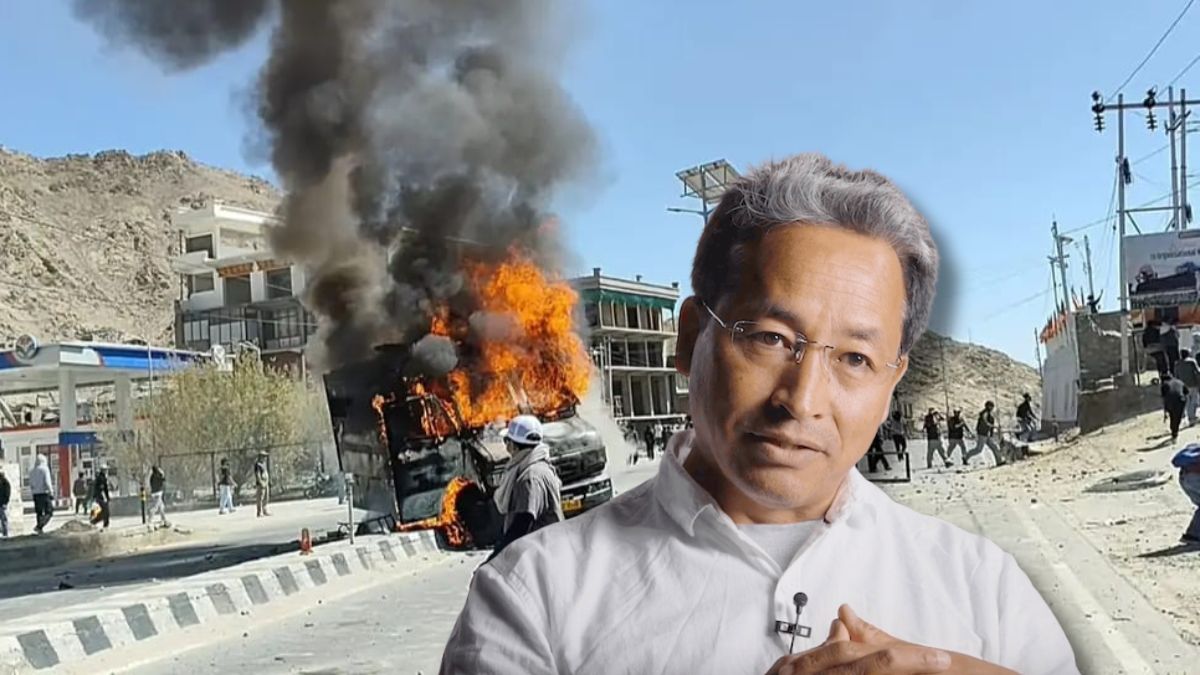In a rather calm, serene, and peacefully valley, a tumult has caused massive ruckus in Ladakh, which is currently under curfew after 4 people were killed in protests. The region
witnessed its worst violence in decades on Wednesday (September 24, 2025), leaving 4 people dead and over 80 injured, including security personnel.
The unrest broke out after two elderly hunger strikers, part of a 35-day fast demanding statehood and Sixth Schedule protections, collapsed and were hospitalized. Their condition sparked anger among locals, especially the youth, leading to protests, arson, and clashes with police.
Security forces fired teargas and even live rounds to contain the situation, while curfew was imposed in Leh. Now, adding more fuel to the fire, the Ladakh Police on Friday (September 26, 2025) arrested Sonam Wangchuk, a well-known climate activist and education reformer.
Who is Sonam Wangchuk and why was he arrested?
Climate activist and education reformer Wangchuk, was arrested by the Ladakh Police in the afternoon of Friday at around 2:30 pm. Officials said he was taken into custody by a team led by DGP SD Singh Jamwal and later shifted out of Ladakh. Though police have not officially confirmed the charges.
Sources, however, indicated that the National Security Act (NSA) has been invoked against him, according to several media reports.
Was Wangchuk responsible for Ladakh violence?
The Home Ministry attributed the mob violence and arson to Wangchuk’s alleged “provocative speeches”, which reportedly invoked references to the Arab Spring and youth-led protests in Nepal. Authorities argue these remarks fueled unrest that turned his hunger strike into a flashpoint.
Wangchuk, however, has alleged that the government is building a case to silence him and jail him for his activism.
No foreign donations for Wangchuk?
A day before his arrest, the Centre cancelled the Foreign Contribution (Regulation) Act (FCRA) licence of Wangchuk’s NGO, SECMOL, citing multiple violations. The move effectively bars the organization from receiving foreign donations. Mobile internet services in Leh were also suspended as a precaution to curb further mobilization.
According to official sources, Wangchuk and his associated organizations are under scrutiny for the following –
FCRA violations: depositing local donations in foreign funding accounts.
Diversion of funds: including Rs 6.5 crore allegedly transferred to his private firm, Sheshyon Innovation.
Unaccounted remittances: over Rs 1.5 crore foreign funds reportedly received by HIAL (founded by Wangchuk) without FCRA approval.
Suspicious transactions: around Rs 2.3 crore allegedly sent abroad between 2021 and 2024.
Undeclared bank accounts: multiple accounts linked to Wangchuk, SECMOL, HIAL, and Sheshyon allegedly not disclosed.
The CBI has now begun probing these charges at the Home Ministry’s request, while the Income Tax Department is investigating potential financial irregularities.
Leh protests: Why were people taking to the streets?
The protests centre on demands for statehood for Ladakh and inclusion under the Sixth Schedule of the Constitution, which provides special protections for tribal and indigenous communities. Since Ladakh’s separation from Jammu & Kashmir in 2019, local groups have expressed concern about demographic change, loss of land rights, and reduced autonomy.
The immediate flashpoint came on Tuesday evening, when two hunger strikers – 72-year-old Tsering Angchuk and 60-year-old Tashi Dolma – were hospitalized in critical condition. Their collapse triggered widespread youth-led protests across Ladakh. By Wednesday morning, large crowds gathered in Leh’s Martyrs’ Ground.
The protests quickly escalated into violence, with vehicles set on fire and security forces clashing with demonstrators.
Meanwhile, the arrest of Wangchuk and the invocation of NSA against him marks a turning point in Ladakh’s statehood agitation. While the government views him as a destabilizing figure, his supporters see the move as an attempt to suppress dissent. Investigations expanding into his finances and protests still simmering, will drive the future of protests.
